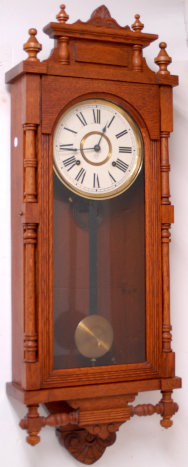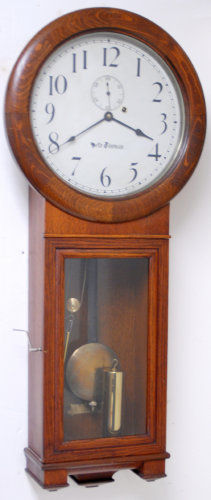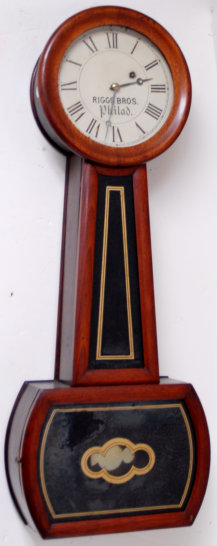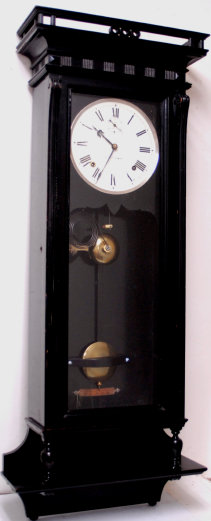

136. $300
“Seth Thomas Clock Co., Thomaston, Conn.”, weight driven wall clock, No. 2 Regulator, ca 1915.
This model is the most extensively manufactured clock ever made. They changed it only slightly over a 100-year period of making them.
The 36” oak case is clean, polished, and appears to be excellent. They do not get any nicer than this one. It is all original with
the exception of the replaced movement, signed by the American Clock Co. and surely a repainted dial, for it is far too nice to be
original. The hands, pendulum, wood stick, brass weight, pulley, beat scale, door lock, and both glasses, are original. The brass
8-day, time only movement is clean and running. The label inside also looks to be too nice to be original but they did a good job
making it appear to be original. If you do not own a ST No. 2, you might consider this one. It looks like, and is, a ST No. 2 Regulator
and a much lower price than one with a correct movement. If I were running the country I would insist every American family buy a
ST No. 2. Failing that, maybe the government could give them one. Ly-Seth Thomas, pages 276-278. $350-$500.

137. $650
Lenzkirch, Germany, shelf clock in the Neuchatel style, ca 1878. The Neuchatel style means it was made like the clocks that were made in Neuchatel, Switzerland. Many companies copied that style which was a very popular style of mantel clocks. Our clock is 20 ½ inches high, case made with burl walnut veneered with a large number of cast ornaments with gold gilt prevailing. The gold is bright, no doubt original but well maintained or cleaned occasionally without removing the gilt. The clock is in excellent condition and certainly an eye catcher. The white enamel dial and hands are perfect and there is a bowed glass in the sash. On the back is a hinged door with cloth covering over a brass screen. The 8-day movement is signed by Lenzkirsch and has a serial number #306280. The movement was recently cleaned and serviced and is running and striking properly. The nickel bell and brass pendulum are the correct style for this clock. This is an uncommon model and a very attractive one. We found an identical clock sold recently at an east coast auction for well over $1000. $750-$1000.
135. $125
Sessions Clock Company, Bristol, Conn., metal cased mantel clock, “Diana”, ca 1910. For Sessions
this is a large metal clock, 17 inches high and originally with a bronze finish, now dark but still a nice-looking clock. The dial
paper was replaced, hands look to be correct, has a brass bezel with flat glass, and a pendulum and key. Not sure if the pendulum
is original. Ly-Sessions #423. $150-$250.


138. $600
“Riggs Bros. Philad.”, signed on the dial of this ca 1840 banjo clock. It is an 8-day, weight
driven model that was so popular in the early banjo making days. Having spent far too much time researching this clock and maker,
and learning little, I turned to “Volume 3, American Clocks, American Clockmakers & Watchmakers”, by Sonya L. & Thomas J.
Spittler, and Chris H. Bailey. They wrote, “William H. C. Riggs was an agent for E. Howard & Co., sold many clocks to various
railroads in and around Philadelphia, and that probably all the clocks were made by “Howard”. In all my research it seems they were
not consistent in the ways they signed the dials. This clock to most collectors would be a Howard No.5 Banjo. We believe it is made
of cherry and was false grained originally. This case is almost 29 inches and still in very nice condition. The movement is 8-day,
time only, weight driven, and running. The glasses, dial, weight and pendulum are all very nice. The weight looks like a Howard weight
but not marked. Some NAWCC Bulletin articles discuss this maker and their clocks. $750-$1000.
134. $225
Ansonia Clock Co. hanging, “Queen Elizabeth”, ca 1901. The walnut case is 37” high, the original
finish has been cleaned and polished not stripped. A new paper dial with the Ansonia logo was installed on the old pan, all the brass
was polished, movement cleaned and serviced, so that now it is ready to hang and enjoy. I cannot find any flaws, or replaced parts
on the wood case. We believe all the finials and other wood parts are original to the case. The door glass, pendulum bob, pendulum
stick, and the hands, are probably original to the clock. On the back is a paper label, about 95% still intact. Ly-Ansonia #620.
Books for $1050. $30-$500.


139. $1000
“Seth Thomas Clock Company. Thomaston, Conn.”, wall clock, “Suez”, ca 1883. In an ebonized
case 44 inches high with unusual features on top and bottom. Seth’s designers had something in mind when they designed this case.
In the writeup for the last one I sold I said, “Apparently you could sit a flower pot on top and empty your pockets at night and put
them on a shelf on the bottom”. The clock is entirely original with no repairs or new parts evident. If I didn’t know better I might
say that it was a reproduction. The original dial has no paint flakes as do most Seth Thomas dials this age. It has an 8-day spring
driven movement that is running and it strikes a Cathedral gong on the hours. The dial ring is nickeled, the gong, and damascened
pendulum ball are brass and the beat scale is nickel. Below the beat scale is a complete black label from which the first line above
was copied. I could not believe when checked back thru tens of thousands of clock sales and saw that I had only sold one Suez in 45
years. You will never find a nicer Suez, or any Seth Thomas for that matter. Ly-Seth Thomas, page 328. $1500-$2000.
